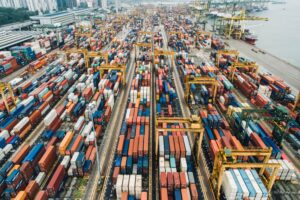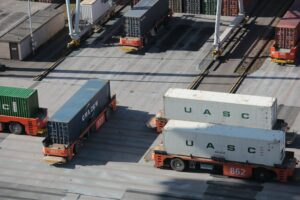Logistics is a dynamic global business yet, as we shall see below, it lags other sectors in digital transformation. In this guest blog post, Mrinmoy Chakraborty, Vice President and Head of IoT at SOLiD, talks about an innovative new IoT solution and the roadmap it unfolds for the industry.
Logistics companies are in an urgent need to stamp out inefficiencies in complex supply chains. Doing so will deliver significant and far-reaching benefits to stakeholders and to our planet. The Internet of Things (IoT) offers a way forward but, until now, fragmented connectivity has constrained its value.
Seeking to fulfil the IoT promise
More than 10 billion pallets, 20 million cargo containers and 900,000 unit load devices (ULDs) are in use by the global logistics business. Failure to maximise these assets can be incredibly costly.
“I know that one major transport operator with 300,000 containers used to spend about $1 billion every year simply moving empty units around. Another multinational company used to write off $1 billion per year on lost, damaged, and under-utilised assets.”
About 10 to 15% of global freight assets are reusable items that logistics service providers (LSPs) rent out to customers. Sharing resources this way increases usage efficiency by about 30%, creating a cost-effective and sustainable alternative to ownership.
Managing these resources has proved challenging for LSPs, so the hope was that IoT technology would help track reusable assets more effectively. But initial solutions tended to be highly localised with limited device connectivity. Modern supply chains don’t fit into neat geographical packages. Assets cross borders, straying into territories covered by different mobile network operators. Without seamless and borderless connectivity, there’s limited cohesion.
Digital supply chains: the missing link
Here at SOLiD, we decided to fix that, but the business case had to stack up.
Given the thin margin of profitability in logistics business, I believe that the cost of tracking technology solution should not exceed more than 10% of the asset value for large scale adoption. Hence the visibility technology makes more sense for high value assets, more so that are reusable, returnable and follow the business models of the ‘sharing economy’.
 We focused our efforts on developing an IoT tracking solution for reusable containers, which will allow logistics companies to track their assets across borders anywhere in the world, without having to deal with a host of mobile network operators. For this, we selected Tata Communications MOVE™ for our solution, to offer seamless and borderless connectivity on land and near-shore. Tata Communications added even greater value by customising their off-the-shelf product in line with our vision. With this partnership, we aim to create a connected supply chain, which will benefit the entire logistics ecosystem.
We focused our efforts on developing an IoT tracking solution for reusable containers, which will allow logistics companies to track their assets across borders anywhere in the world, without having to deal with a host of mobile network operators. For this, we selected Tata Communications MOVE™ for our solution, to offer seamless and borderless connectivity on land and near-shore. Tata Communications added even greater value by customising their off-the-shelf product in line with our vision. With this partnership, we aim to create a connected supply chain, which will benefit the entire logistics ecosystem.
Liberating data to create value
To extend connectivity coverage beyond the reach of conventional cellular networks, we are in the development stage of a hybrid multi-modal tracker device called ‘Nirvana Blue’. Switching intelligently between Tata Communications MOVE™ to LPWAN (suitable for low cost local private network with minimal infrastructure) and satellite (the most expensive option and always the last resort), Nirvana Blue is expected to be one of the first solutions to provide seamless multi-modal supply chain connectivity, an approach I expect to gather momentum fast.
I believe that around 20% market adoption is the tipping point for IoT (currently at about 1-2% penetration) in the logistics industry and that Nirvana will help speed up the process while simultaneously releasing data from siloes. LSPs can turn that to their advantage. Consider the following.
Shortening cycle time. In the container industry, cutting an average 100-day cycle time by 10% saves $35 – $49 per cycle per unit. Even more importantly, reducing cycle time enables LSPs to serve more customers and increase revenues.
Reducing damage and losses. Damage and losses can be catastrophic, especially to ULDs in air transportation which must be repaired by specialist technicians. Some of the leading players lose as many as 60 million pallets every year.
Increasing profits. Some of the work we’ve done with our customers shows that cutting logistics costs by around 10% yields a typical improvement of 1.5% in annual profits. That reflects the asset-intensive nature of the industry. High gearing between the capital cost of replacement and operational overheads drives proportionately positive effects on the bottom line through reductions in the former.
New horizons for LSPs?
As these changes take hold, I envisage LSPs evolving into logistics integrators. With data at their fingertips they’ll be able to offer IoT-based services at differentiated price points using Nirvana. With what I’ve dubbed as visibility-as-a-service, customers will be happy to pay to see where pinch points are, with the information necessary to identify and rectify the causes.
For example, tracking the location of an asset could be offered as an entry-level service. Monitoring a cold chain, on the other hand, would add considerable value. In 2018, it was estimated products worth $900 billion were spoiled in broken cold chains. Helping prevent such losses could enable LSPs to charge a premium for that service.
LSPs thus have an opportunity to become orchestrators of the digital supply chain, offering a portfolio of services to suit myriad needs. It’s an exciting prospect.
As well as LSPs, freight operators, manufacturers and food producers could all benefit enormously from these developments. So, too, will our planet.
Winning together: the environment and enterprise
The logistics industry is committed to operating sustainably, and there are huge environmental challenges that Nirvana can help solve. I’ve already mentioned inherent difficulties in the cold chain, but it’s worth looking at them again in the context of food loss.
One third of food produced for humans is currently lost or wasted annually. Initiatives are underway to tackle this. Maersk, for example, carries 27% of the world’s refrigerated containers and a staggering 25% of its food commodities. The company is piloting ways of preventing food spoilage. One is cutting inefficiencies caused by fragmented global cold chains. Nirvana offers similar logistics operators an ideal means of improving efficiency and sustainability in their own cold chains.
So, there’s so much to gain, environmentally and across business ecosystems too. A final word about the size of the opportunity that’s opened by Nirvana. According to my calculations, visibility-as-a-service through connected supply chains would be worth some $5 billion annually in a $38 trillion global industry. Let’s go get it. Together.
Discover more about how the logistics industry is being transformed by technology.
Transformational Hybrid SolutionsOur cloud-enablement services offer the best performance on your traffic-heavy websites or mission-critical applications.
Core NetworksTata Communications™ global IT infrastructure and fibre network delivers the resources you need, when and where you need them.
Network Resources
Unified Communications As A ServiceBreak the barriers of borders efficiently and increase productivity with Tata Communications’ UC&C solutions.
Global SIP ConnectEmpower your business with our SIP network and witness it grow exponentially.
InstaCC™ - Contact Centre As A ServiceCloud contact centre solutions for digital customers experience and agent productivity.
DIGO – Communications Platform as a ServiceDIGO is an in-network cloud communications platform, enabling you to power up converged contextual human-to-everything conversations globally.
Unified Communication Resources Case studies, industry papers and other interesting content to help you explore our unified communications solution better.
IoT SolutionsThe Internet of Things is transforming the way we experience the world around us for good. Find out more about our Internet Of Things related solutions here.
Mobility SolutionsTata Communications’ mobility services enable your enterprise to maintain seamless communication across borders, with complete visibility of cost and usage.
Mobility & IoT Resources
Multi-Cloud SolutionsWith enterprises transitioning to a hybrid multi-cloud infrastructure, getting the right deployment model that yields ROI can be a daunting task.
Cloud ComplianceCompliant with data privacy standards across different countries and is also designed to protect customers’ privacy at all levels.
IZO™ Cloud Platform & ServicesIZO™ is a flexible, one-stop cloud enablement platform designed to help you navigate complexity for more agile business performance.
Managed Infrastructure ServicesIntegrated with our integrated Tier-1 network to help your business grow efficiently across borders.
Cloud PartnersWe support a global ecosystem for seamless, secure connectivity to multiple solutions through a single provider.
Cloud Resources
Governance, Risk, and ComplianceRisk and Threat management services to reduce security thefts across your business and improve overall efficiencies and costs.
Cloud SecurityBest-in-class security by our global secure web gateway helps provide visibility and control of users inside and outside the office.
Threat Management - SOCIndustry-leading threat-management service to minimise risk, with an efficient global solution against emerging security breaches and attacks.
Advanced Network SecurityManaged security services for a predictive and proactive range of solutions, driving visibility and context to prevent attacks.
Cyber Security ResourcesCase studies, industry papers and other interesting content to help you explore our securtiy solution better.
Hosted & Managed ServicesTata Communications provide new models for efficient wholesale carrier voice service management. With our managed hosting services make your voice business more efficient and better protected
Wholesale Voice Transport & Termination ServicesYour long-distance international voice traffic is in good hands. End-to-end, voice access & carrier services which includes voice transport and termination with a trusted, global partner.
Voice Access ServicesTata Communication’s provide solutions which take care of your carrier & voice services, from conferencing to call centre or business support applications.
Carrier Services Resources
CDN Acceleration ServicesOur CDN Web Site Acceleration (WSA) solution helps deliver static and dynamic content, guaranteeing higher performance for your website.
CDN SecuritySafeguard your website data and customers’ information by securing your website from hacks and other mala fide cyber activities.
Video CDNDeliver high-quality video content to your customers across platforms – website, app and OTT delivery.
CDN Resources
Elevate CXIncrease customer satisfaction while empowering your service team to deliver world-class customer experience and engagement.
Live Event ServicesTata Communications’ live event services help battle the share if eyeballs as on-demand video drives an explosion of diverse content available on tap for a global audience.
Media Cloud Infrastructure ServicesTata Communications’ media cloud infrastructure offers flexible storage & compute services to build custom media applications.
Global Media NetworkTata Communications’ global media network combines our expertise as a global tier-1 connectivity provider with our end-to-end media ecosystem.
Use CasesUse cases of Tata Communications’ Media Entertainment Services
Remote Production SolutionsMedia contribution, preparation and distribution are highly capital-intensive for producers of live TV and video content, and their workflows are complex.
Media Cloud Ecosystem SolutionsThe Tata Communications media cloud infrastructure services offer the basic building blocks for a cloud infrastructure-as-a-service.
Global Contribution & Distribution SolutionsTata Communications’ global contribution and distribution solution is built to reduce capital outlay and grow global footprint.
Satellite Alternative SolutionsAs more and more consumers choose to cut the cord & switch to internet-based entertainment options, broadcasters are faced with capital allocation decisions.
LeadershipA look into the pillars of Tata communications who carry the torch and are living embodiment of Tata’s values and ethos.
Culture & DiversityHere at Tata Communications we are committed to creating a culture of openness, curiosity and learning. We also believe in driving an extra mile to recognize new talent and cultivate skills.
OfficesA list of Tata Communications office locations worldwide.
SustainabilityTata Communications adopts a holistic approach and harnesses the power of new-age technologies like 5G, IoT and AI to build a sustainable digital world.
FAQCheck out our FAQs section for more information.
BoardHave a look at our board of members.
ResultsFind out more about our quarterly results.
Investor PresentationsFollow our repository of investor presentations.
FilingsGet all information regarding filings of Tata communications in one place.
Investor EventsAll investor related event schedule and information at one place.
GovernanceAt Tata, we believe in following our corporate social responsibility which is why we have set up a team for corporate governance.
SharesGet a better understanding of our shares, dividends etc.
SupportGet all investor related contact information here.


